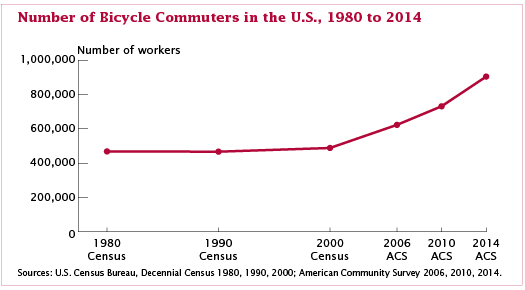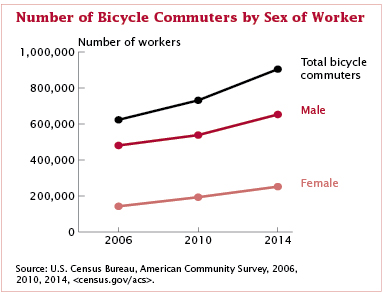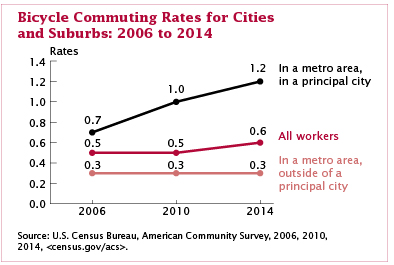
An official website of the United States government
Here’s how you know
Official websites use .gov
A .gov website belongs to an official government organization in the United States.
Secure .gov websites use HTTPS
A lock (
) or https:// means you’ve safely connected to the .gov website. Share sensitive information only on official, secure websites.
-
//
- Census.gov /
- Census Blogs /
- Random Samplings /
- A Look at the Nearly 1 Million Who Ride Their Bikes to Work in the U.S.
A Look at the Nearly 1 Million Who Ride Their Bikes to Work in the U.S.
A Look at the Nearly 1 Million Who Ride Their Bikes to Work in the U.S.
The proportion of workers who commute by bicycle has remained small, but relatively steady over the last few decades. The number of bike commuters, which has grown to nearly 1 million, has increased at roughly the same rate as the labor force, which has not been the case for some modes of commuting such as transit and walking.
Are men or women more likely to bike to work?
The number of men who bicycle to work still exceeds that of women, but the gender gap is narrowing. Women workers made up 28 percent of bike commuters in 2014, up from about 23 percent in 2006. Men made up about 77 percent of bicycle commuters in 2006, compared with 72 percent in 2014.
Do bike commuters tend to be younger?
Yes, the bicycle commuting rate generally declines as age increases. Younger workers not only had the highest rate of bicycle commuting but have also had comparatively large gains in bike commuting since the mid-2000s. Between 2006 and 2013, the rate of bike commuting for ages 16 to 24 increased from 0.8 percent to 1.1 percent. The rate also went up for those age 25 to 29. The highest rates tend to be in small college towns. For example, 9.7 percent of workers in Berkeley, Calif., and 23.2 percent in Davis, Calif. — both home to University of California campuses — biked to work in 2014.
Where do you see bike commuting on the rise the most?
Much of it is in metropolitan areas, specifically in cities, where bicycle commuting has increased over the last decade, both in number and as a proportion of all workers. The proportion of bicycle commuters in principal cities nearly doubled from 0.7 percent in 2006 to 1.2 percent in 2014. Many cities have invested in infrastructure to accommodate bicycle commuting. Starting in about 2010, bike-sharing systems started showing up in cities, large and small. Many cities have also invested in dedicated bicycle lanes and other elements of the built environment that make streets more bicycle friendly. Portland, Ore., for example, increased its bicycle commuting rate from 4.2 percent in 2006 to 7.2 percent in 2014. In Minneapolis, the rate went from 2.5 percent to 4.6 percent during that period.
Share
 Yes
Yes
 No
NoComments or suggestions?


Top




